The Intel SSD 545s (512GB) Review: 64-Layer 3D TLC NAND Hits Retail
by Billy Tallis on June 27, 2017 6:00 AM ESTBAPCo SYSmark 2014 SE
BAPCo's SYSmark 2014 SE is an application-based benchmark that uses real-world applications to replay usage patterns of business users in the areas of office productivity, media creation and data/financial analysis. In addition, it also addresses the responsiveness aspect which deals with user experience as related to application and file launches, multi-tasking etc. Scores are calibrated against a reference system that is defined to score 1000 in each of the scenarios. A score of, say, 2000, would imply that the system under test is twice as fast as the reference system.
SYSmark scores are based on total application response time as seen by the user, including not only storage latency but time spent by the processor. This means there's a limit to how much a storage improvement could possibly increase scores, because the SSD is only in use for a small fraction of the total test duration. This is a significant difference from our ATSB tests where only the storage portion of the workload is replicated and disk idle times are cut short to a maximum of 25ms.
| AnandTech SYSmark SSD Testbed | |
| CPU | Intel Core i5-7400 |
| Motherboard | ASUS B250-PLUS |
| Chipset | Intel B250 |
| Memory | 2x 8GB Kingston DDR4-2400 CL17 |
| Case | In Win C583 |
| Power Supply | Cooler Master G550M |
| OS | Windows 10 64-bit, version 1703 |
Our SSD testing with SYSmark uses a different test system than the rest of our SSD tests. This machine is set up to measure total system power consumption rather than just the drive's power.
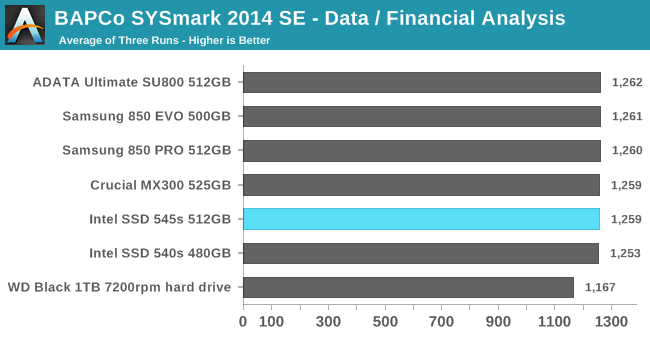
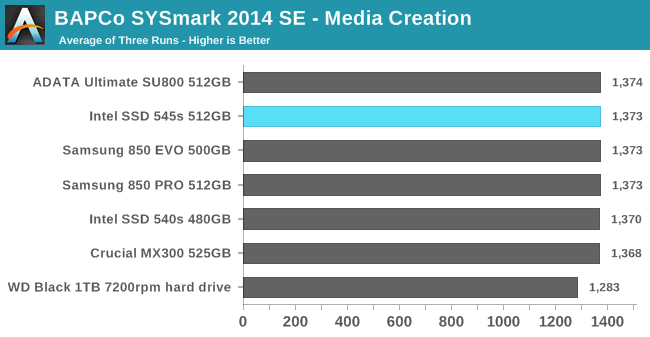
The SYSmark performance scores for data analysis and media creation are relatively insensitive to storage performance, as shown by our test system's score with a mechanical hard drive exceeding the normalized score of 1000 for the SYSmark reference system that uses a SSD and coming relatively close to the performance of our SSDs. The differences between these SATA SSDs are all within the variation between runs.
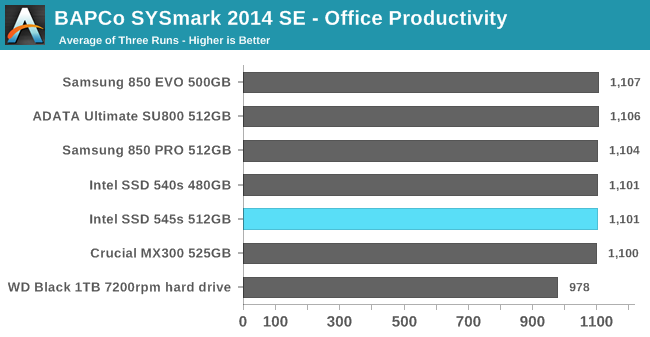
The office productivity test also shows very little dependence on storage performance, but the gap between the SSDs and the hard drive is a bit wider than for the first two usage scenarios, and the hard drive's detrimental impact on performance was enough to offset the CPU and RAM advantages our testbed has relative to the SYSmark 2014 SE reference system.
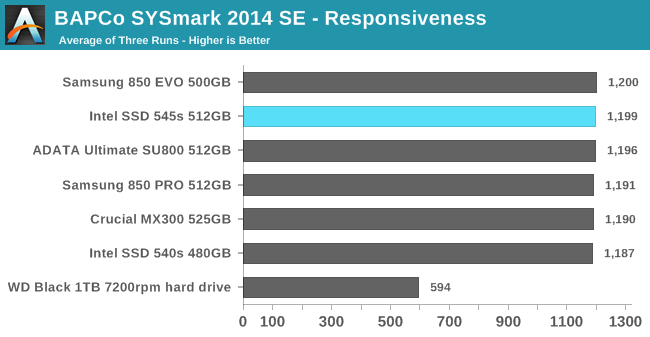
The SYSmark responsiveness benchmark is the most sensitive to storage performance, and all of the SATA SSDs are about twice as fast as the mechanical hard drive. The difference between SSDs is just barely larger than the variation between test runs, but it's enough that the slowest of the three runs for the 545s was faster than the fastest of the three runs for the Intel 540s.
Energy Usage
The SYSmark energy usage scores measure total system power consumption, excluding the display. Our SYSmark test system idles at around 26 W and peaks at over 60 W measured at the wall during the benchmark run. SATA SSDs seldom exceed 5 W and idle at a fraction of a watt, and the SSDs spend most of the test idle. This means the energy usage scores will inevitably be very close. A typical notebook system will tend to be better optimized for power efficiency than this desktop system, so the SSD would account for a much larger portion of the total and the score difference between SSDs would be more noticeable.
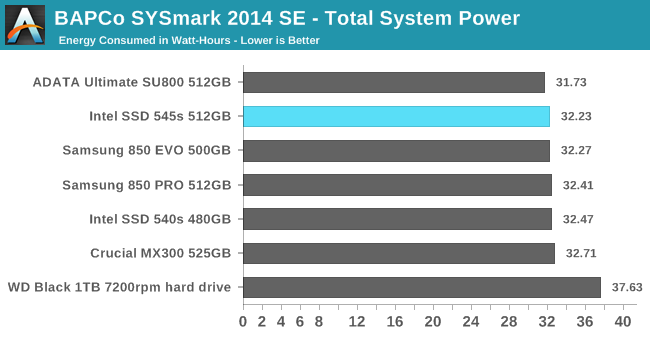
Rather than judging these scores by their percentage difference, it's probably more useful to consider the raw number of Watt-hours saved by using a more efficient SSD. The difference here between the best and worst SSD is just under 1 Wh, compared to a typical ultrabook battery capacity of around 50 Wh. Since the overall performance scores with each SSD were so close together, we know that the test runs took essentially the same amount of time and the differences in energy usage are due mostly to differences in the idle power consumption of the SSDs.










74 Comments
View All Comments
woggs - Tuesday, June 27, 2017 - link
Once a nand factory is running on a new generation, it has to sell components. The only path out the door for nand is an SSD (for Intel). A product like this gets out quicker and starts the flow. Not a big money maker but gets the factory running in it's early stages.nevcairiel - Tuesday, June 27, 2017 - link
I hope 64-layer TLC brings us closer to more affordable consumer "mass storage" SSDs. I would love to replace my 3TB storage spinning drive with a SSD, but I would need at least that space again - and right now thats still very expensive.MajGenRelativity - Tuesday, June 27, 2017 - link
That is definitely needed. SSD prices need to continue to decline in order to finally finish off HDD's once and for allHomeworldFound - Tuesday, June 27, 2017 - link
That's going to be a slow process, one the mechanical storage companies are going to want to slow down even further.mkozakewich - Wednesday, June 28, 2017 - link
Why not a 6TB HDD?Mechanical drives look like they'll keep their edge on raw capacity for the foreseeable future. You're best off with a dual system.
Drumsticks - Tuesday, June 27, 2017 - link
The SSD 540 was a disappointing product that honestly should have pretty much never been released. It sucked. This one is much better! It's not the best, but it's certainly competitive, and that performance on the destroyer looks great. Kudos to Intel.We just need the price to go down. I bought a 512GB Crucial MX100 years ago for $163 on sale. It's crazy how high prices have gotten recently.
mkozakewich - Wednesday, June 28, 2017 - link
Ha, I remember just a few years ago when the prices were hovering around $1/GB! It kind of feels weird to hear people complaining about high prices at 30-40¢/GB.Remember the Intel X25-M in 2009 for over $500? For 60 GB? AnandTech covered that by benchmarking application start times compared to HDDs. There was this whole problem with janky SSDs, so they described the problem and ran tests on those other low-end SSDs.
We've come so far!
eddieobscurant - Tuesday, June 27, 2017 - link
The bapco benchmark is useless. The differences are negligible . Please don't include it in the new 2017 benchmark suite.lilmoe - Tuesday, June 27, 2017 - link
Totally disappointed. This just gets a tiny bit closer to the 850 EVO, yet it's a bit more expensive ($20 more for 512GB drives).I was hoping Samsung would be under real pressure to lower prices, but this just makes the 850 EVO seem a bit more competitive; it's a bit cheaper, proven for a while to be reliable (ie: a safer bet), and supports more features like encryption.
Seriously, are they even trying? Hoping some REAL competition is on the way shortly from the others...
I smell price fixing shenanigans.
Impulses - Tuesday, June 27, 2017 - link
It's kind of startling how long the 850 EVO has dominated for... It launched at the end of 2014, over 2.5yrs ago now, and pricing has remained more or less constant for the last 2 years (at least for the 1TB I've bought, same today as in the summer of 2015).When has a single storage product ever had that long of a run without a serious challenger? Even Samsung decided to ride it after quickly iterating (and suffering some issues along the way) thru the 430 - 830 - 840.